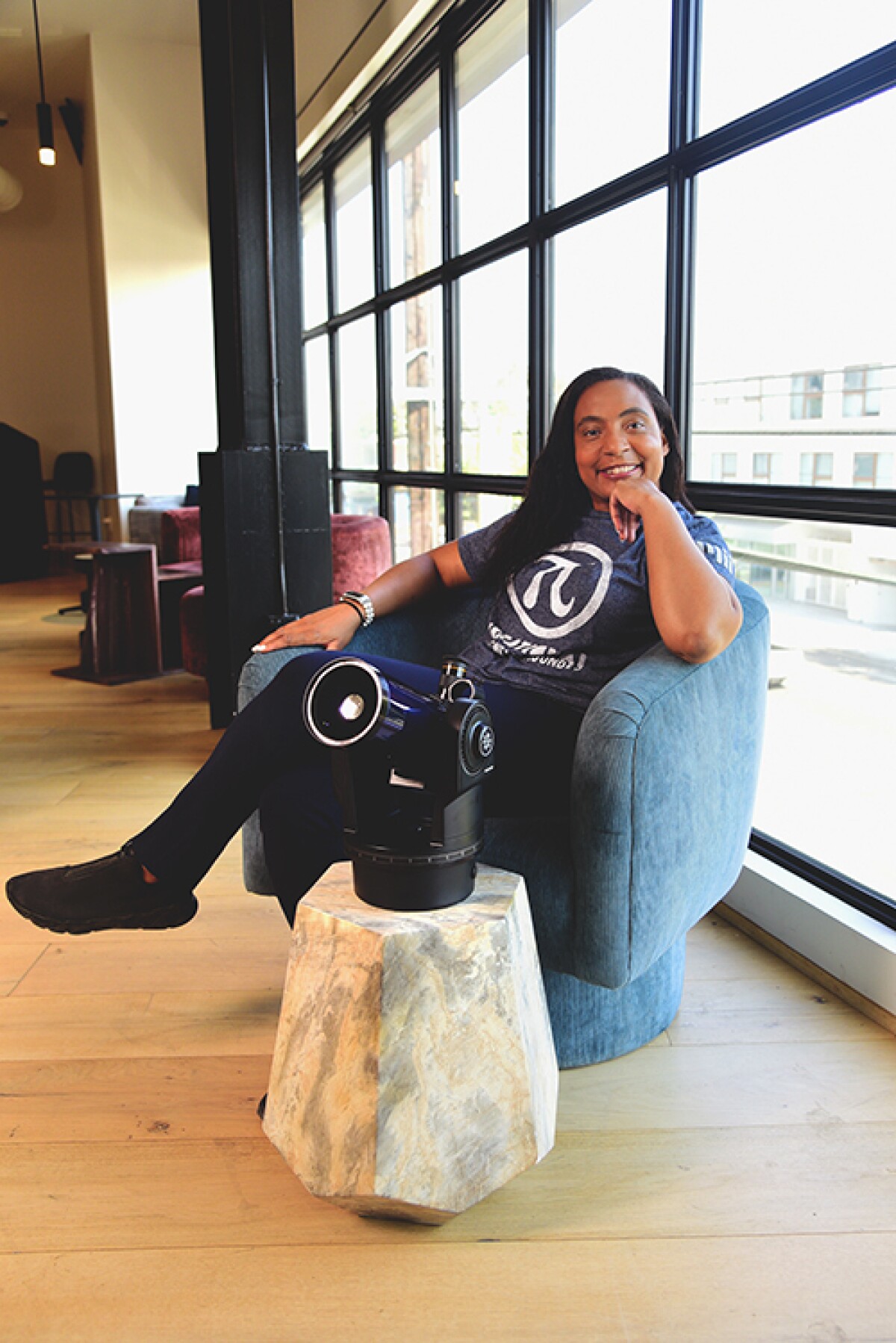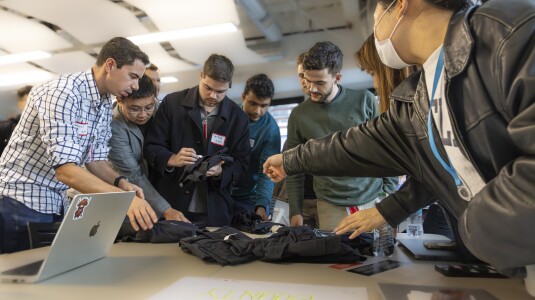“I work in robotics and artificial intelligence. We're building robots that are going to help the world.” As introductions — or elevator pitches — go, that’s an especially strong one.
That’s how Nia Jetter, senior principal technologist for Amazon Fulfillment Technology Robotics, answers the question: What do you do?
Jetter is an engineer who has been recognized throughout her career for her accomplishments in autonomous systems, so her confidence is earned. Her goals extend beyond developing new algorithms, and include lowering barriers to understanding technology and cultivating a more diverse workforce.
“At Amazon, I am working on laying a foundation for how we build collaborative autonomous systems safely across our robotics platforms,” Jetter notes. “I’m also working on forward looking research on ways to architect and develop safety critical autonomous systems in a way that is verifiable while leveraging techniques like machine learning.”
Jetter’s work is centered on improving components of Amazon’s delivery operations by focusing on embedding best practices into the design process. She believes automation, achieved with artificial intelligence and next-generation robots, can deliver improvements for both Amazon employees and customers.
“People want their packages quickly, including me,” she says with a laugh. “So, when you look at our fulfillment centers, I'm hugely passionate about: What are the ways that we can help my colleagues working there? How can we help our customers?”
To that end, Jetter, along with other scientists and engineers within her organization, is analyzing activities that could be more easily and safely accomplished with robots. In order to support this work, her team and others across Amazon collaborate with a variety of universities, including the University of Washington. Jetter sits on the advisory board for the UW-Amazon Science Hub and also serves as an Amazon research liaison.
“We are working on developing solutions to challenges faced across multiple industries and are working to do so in a scalable fashion by developing in a way that supports modularity. There is a lot of space for innovation in safe autonomy, AI, and robotics,” she said. “I am passionate about pursuing research that can be inserted into products in that space.”
An early love for learning
Jetter displayed engineering talent from a young age.
As a second grader she would find scrap insulated wire at the base of utility poles, and would save quarters given to her by her grandfather for small chores to buy LEDs, light bulbs, and batteries from RadioShack. Her father, a mail carrier, would help her find books that explained electrical circuits. While in elementary school, she used a piece of foam core and her RadioShack purchases to create an illuminated Valentine’s Day card for her science teacher.
Her path shifted toward computer programming while she was still in elementary school. She took a computer class and said her interest was immediately piqued. She began spending her spare moments in the computer room writing programs in HyperCard, soon followed by Fortran, Pascal, and C.
“I loved programming at school,” she says. “I would go on my lunch hour and stay after school. Looking back, while at the time I did not think of it as something I would do for a career, I realize I was good at it.”
In high school, she received a letter from MIT encouraging her to apply to the MIT Introduction to Technology, Engineering, and Science (MITES) program. At the time, the program took 50 high school students and brought them to campus to take intense science and engineering classes and to familiarize them with the institute.
He didn’t see me as a black girl who was good at math. He saw me as a mathematician. That meant the world to me.
Jetter said the magnitude of the potentially life-changing opportunity was not immediately evident to her, namely because she had never heard of MIT. “Little did I realize that that letter, and attending the MITES program, would become a significant part of my origin story as an engineer,” she noted.
Her experience with MITES led directly to enrolling at MIT. She intended to study biochemical engineering, but while there she was exposed to more advanced math and computer science classes and found that she loved them. Her career path was set when, in her sophomore year, she took an artificial intelligence class with the late Patrick Henry Winston, her future mentor and then director of the MIT Artificial Intelligence Laboratory.
“There are several points in my journey where I met people who saw more in me than I saw in myself, people who filled a gap for me through exposure to what was possible. Professor Winston saw me as a scientist and a mathematician first, and encouraged me to push the envelope and be all that I could be.

“He didn’t see me as a black girl who was good at math. He saw me as a mathematician. That meant the world to me,” Jetter says.
A lifelong science fiction fan, Jetter also set her sights on working for NASA. She interned there for three summers.
“When I was on the atmospheric experiments team, I recognized that their algorithms could be improved. I’m not sure they took the suggestion from an intern seriously, but I wrote a paper explaining what I saw, and I gave it to the department head,” she recalled. “The next Monday, he came into the office and told me to get started.
“What I learned from my NASA internships was the value of being a mathematician or a computer scientist. I learned that every team needs a computer scientist.”
Before her graduation from MIT in 2000, a chance encounter with a recruiter from Hughes Space and Communications (acquired in October 2000 by Boeing) convinced her to work there on a project involving automated controls. Although she had some early challenges, she quickly realized she could solve those by drawing on her own experiences.
“I derived mathematical models and eventually I was asked to ‘Derive the gains for the controller.’ At the time I had no idea what that meant. I was fortunate to be taught by leaders in the field and quickly learned that a controller is very analogous to an intelligent agent in how it needs to perceive, make decisions and act on its environment. That work led me to enroll at Stanford in 2005 to get a master’s degree in aeronautical and astronautical engineering while I worked at Boeing.”
A milestone moment
In 2013, her work at Boeing led to her being honored as a Boeing associate technical fellow – the first tier of the Technical Fellowship. At the Boeing facility in El Segundo, California, in what is called the “hall of flags,” there is a wall with photos of the Boeing technical fellows.
“From when I first saw the wall, I knew that one day my face would be on it. I’ll never forget the day I walked down the hall and my photo was up! I was the first black woman with my face on the wall at my site. I didn’t realize the photo would mean so much to me, but when I first saw it on the wall, it really stood out.”
In 2020, Jetter made what she admitted was a hard decision. “I decided to leave aerospace in order to be able to innovate faster and to see the fruits of innovation sooner.” She knew that kind of opportunity existed at Amazon, and joined the company in January 2021 to work with the robotics team.
“While I thought that I was making a decision to leave aerospace, I was actually making a decision to expand my expertise in autonomy and AI. So much of the work that I do now is enabled by my aerospace foundation. What excites me about robotics and artificial intelligence at Amazon is the opportunity to truly change the game, change how we do things for an additional set of customers,” Jetter said.
Blazing a trail
As a leader in AI and robotics, Jetter says many people approach her with interest in pursuing a similar path, asking whether they can emulate her. Many of those who approach her have what is for her a familiar experience: a lack of exposure.
“This has inspired me because I am often approached by people who clearly have the aptitude but have not been exposed to a mechanism — including tools they need to progress down the path. Sometimes they just need exposure to people who look like them going down the path. As a result, in addition to building a solid tech foundation, when mentoring I focus on exposure, encouragement, and helping people see things that they might not see in themselves.”
That’s also why diversity matters for human beings solving complex science and engineering problems. If you have diverse perspectives in the room, you can arrive at the optimal solution for the target customer faster.
To lower the barriers to entry, Jetter makes time to provide guidance to others. She does this in a number of ways, including small group mentoring sessions that she calls “Shades of Tech”. In addition, earlier this year Jetter spearheaded the Amazon in the City Responsible AI Panel with support from Amazon’s Inclusive Experiences and Technology team. The event brought together “leaders from within and outside Amazon to share perspectives on the importance of fairness in tech as AI-based technology is developed and deployed.”
Along with Jetter, attendees heard from Nashlie Sephus, principal AI/ML evangelist with Amazon Web Services; Chad Jenkins, associate chair of undergraduate studies and professor of robotics at the University of Michigan; and Nii Simmonds, non-resident fellow at the Center For Global Development. The panelists spoke about responsible AI and the impact of diversity in the workforce.
Jetter drew on her own past experiences when pondering the initiative.
“There are certain types of optimization algorithms where, when you're optimizing, you get to a point at which you're actually converging on a local solution, as opposed to the global solution. And in order to get to the global solution, you actually need to inject variety – you have to inject diversity in your dataset.
“That’s also why diversity matters for human beings solving complex science and engineering problems. If you have diverse perspectives in the room, you can arrive at the optimal solution for the target customer faster.”
In another effort to expand access, Jetter created a series of YouTube videos explaining automation and artificial intelligence called “Thinque Bytes.”
“I feel very fortunate to be where I am today. I want to provide exposure to enable as many people as possible who might not have easy access to the knowledge and the technology to learn and eventually have impact in these fields.”







